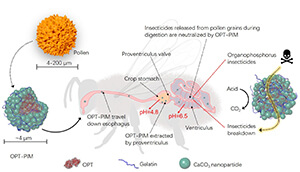
Since my lab currently conducts pesticide risk assessments for bees, I sometimes hear feedback along the lines of, “Scott, it seems like you’re always focusing on the problems instead of finding solutions.” While I’m certainly sympathetic to this criticism, I would argue we first need to understand if (or when) there’s a problem before coming up with a solution.
But sometimes we already know there’s a problem and can focus on solutions. Such is the case for bee exposures to some organophosphate insecticides. Bees aren’t exposed to harmful levels of organophosphate insecticides all the time, but they are sometimes, especially during crop pollination. Indeed, a recent worldwide meta-analysis of in-hive pesticide residue studies found that, under current use patterns, five insecticides pose substantial risk to bees: chlorpyrifos, clothianidin, imidacloprid, phosmet, and thiamethoxam (Sanchez-Bayo & Goka 2014). Two of these insecticides (chlorpyrifos and phosmet) are organophosphates.
So, what if we could make honey bees immune to organophosphate insecticides? Specifically, what if we could feed them something that detoxified organophosphates in their bodies before the bees were harmed? And what if this supplement was something that could easily be added to sugar syrup or pollen patties? These are the topics for our forty-third Notes from the Lab, where we summarize “Pollen-inspired enzymatic microparticles to reduce organophosphate toxicity in managed pollinators,” written by Jing Chen and colleagues and published in the journal Nature Food [2021]. Full disclosure: I am a co-author on this study.
For their study, Chen and colleagues actually conducted an arsenal of studies. Because of this, it’s useful to start with their overall approach. Very simply, the main idea is to feed bees enzymes that detoxify organophosphate insecticides before they’re absorbed and harm the bee (Figure 1).
A major trick with this approach is getting the enzymes past the crop (stomach), which is acidic and breaks down enzymes. To do this, the authors needed to load the enzymes into a protective microparticle casing. This can be seen at the left side of Figure 1, where the light blue sphere with the reddish inside is the object of interest. The light blue sphere represents the microparticle casing, the red represents amidohydrolase phosphotriesterase (OPT) enzymes (i.e., the enzymes that detoxify organophosphates), and the dark blue squiggles represent gelatin, which stabilizes everything. If you look from left to right, you can see how the enzyme-loaded microparticle is ingested by the bee, travels through the acidic crop, then is available to detoxify organophosphates in the midgut where digestion and nutrient/toxin absorption occur in bees.
First, Chen and colleagues needed to manufacture a microparticle that was uniform in size and stable enough in sucrose to be fed to bees, while at the same time capable of being loaded with enzymes that could interact with organophosphates. To do this, they combined CaCl2, Na2CO3, and gelatin and prepared the mixture with a precise recipe. Next, they added the enzyme (OPT) at various concentrations, eventually finding that 0.5 mg/ml was a sweet spot where paraoxon (an organophosphate insecticide) was rapidly metabolized and the sucrose solution was attractive to bees. They also tested the durability of the OPT-loaded microparticles for metabolizing paraoxon and malathion (both are organophosphate insecticides) across a range of temperatures, pH conditions, and up to 14 days after manufacturing. Finally, they measured acetylcholinesterase (AChE) activity in the presence of paraoxon. Since AChE is inhibited by organophosphates such as paraoxon, high AChE activity indicates effective detoxification.
Since the preliminary experiments were looking very promising, at this stage the authors tested the OPT-loaded microparticles in bees. They started by assessing whether microparticle loading allowed enzymes to remain in bee guts longer than enzymes that weren’t loaded in microparticles (Figure 2). Then they dosed bees with paraoxon or malathion and directly tested whether OPT-loaded microparticles protected the bees from these organophosphate insecticides.
So, what did they find? Were the OPT enzymes durably loaded into microparticles? Yes. Loading the OPT enzymes into microparticles made the enzymes much more ….


